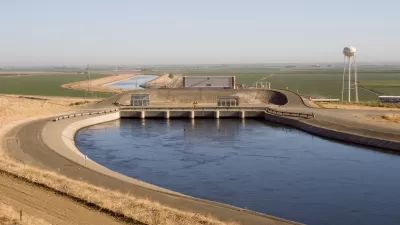Emily Wortman-Wunder looks at the effectiveness of conservation development - a popular tool used by planners across the rural West for the purposes of preserving open space.
Wortman-Wunder investigates the growing application of conservation development or Land Preservation Subdivision (LPS) ordinances - in which developers are given density bonuses for leaving 40 to 80 percent of a typical rural parcel as open space - which "seem to offer a way for mountain communities to have it all."
With an estimated
10 million acres across the U.S. preserved using conservation development since the 1960s, Wortman-Wunder questions the goals of such practices, and what they achieve.
For example, Sarah Reed, a conservation biologist with Colorado State University
and the Wildlife Conservation Society, found that, "While over a third of the
counties [in 11 western states] had regulations that promoted some form of conservation
development, many did so in ways unlikely to preserve critical wildlife
habitat or other natural values. Few promoted land stewardship, or
ensured that open space parcels were contiguous within or among
developments."
Questions also surround the basis for deciding which areas are allowed to be developed and which preserved, management of the conserved land, and lot size. "All of these issues contribute to a growing sense that clustered
development is not living up to its promise," writes Wortman-Wunder.
Thanks to Anthony Flint
FULL STORY: Do subdivisions designed for conservation actually help wildlife?

Pennsylvania Mall Conversion Bill Passes House
If passed, the bill would promote the adaptive reuse of defunct commercial buildings.

World's Largest Wildlife Overpass In the Works in Los Angeles County
Caltrans will soon close half of the 101 Freeway in order to continue construction of the Wallis Annenberg Wildlife Crossing near Agoura Hills in Los Angeles County.

U.S. Supreme Court: California's Impact Fees May Violate Takings Clause
A California property owner took El Dorado County to state court after paying a traffic impact fee he felt was exorbitant. He lost in trial court, appellate court, and the California Supreme Court denied review. Then the U.S. Supreme Court acted.

Indy Bikeshare System Turns 10, Expands to E-Bikes
Pacers Bikeshare riders logged over 700,000 rides since the system launched in 2014.

Coming Soon to Ohio: The Largest Agrivoltaic Farm in the US
The ambitious 6,000-acre project will combine an 800-watt solar farm with crop and livestock production.

New York’s Deadliest Neighborhoods for Pedestrians
Pedestrian deaths rose last year, but remain below pre-2020 levels.
City of Costa Mesa
Licking County
Barrett Planning Group LLC
HUD's Office of Policy Development and Research
Mpact Transit + Community
HUD's Office of Policy Development and Research
Tufts University, Department of Urban and Environmental Policy & Planning
City of Universal City TX
ULI Northwest Arkansas
Urban Design for Planners 1: Software Tools
This six-course series explores essential urban design concepts using open source software and equips planners with the tools they need to participate fully in the urban design process.
Planning for Universal Design
Learn the tools for implementing Universal Design in planning regulations.


























